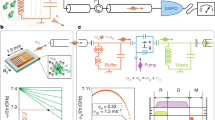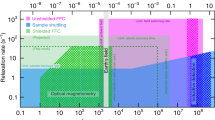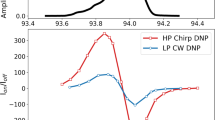Abstract
MOST of the methods in current use for producing radicals from crystalline solids for study by electron spin resonance involve the use of high-energy radiation and therefore require comparatively expensive and elaborate equipment. Papazian1,2 showed that several substances, including hydrazoic acid and methyl iodide, condensed from the vapours at liquid-nitrogen temperature developed colour when sparked with a Tesla-coil; this was attributed to free-radical formation. Using the electron spin resonance technique we have found that radical concentrations as high as 1018/gm. (approximately 10−3 mole 1.−1) can be obtained by applying the discharge from an ordinary vacuum leak-tester to finely ground crystals of many organic substances contained in partially evacuated electron spin resonance specimen tubes. For low-melting solids, for example some vinyl monomers, the following procedure is sometimes convenient. The degassed liquid is frozen in a thin layer on the walls of the evacuated tube, which is then cooled to −195° C. and vibrated vigorously. The crystals are thus detached from the walls and deposited in a fine powder at the bottom of the tube. A suitable gas at a pressure of about 0.1 mm. mercury is admitted and the probe of the Tesla-coil applied in the neighbourhood of the crystals, the tube being maintained at a low temperature and preferably vibrating. With high-melting solids it suffices to grind the crystals finely in a mortar before introduction into the specimen tube. Nitrogen, hydrogen, argon and oxygen have been used, in order of decreasing effectiveness. The presence of a gas is desirable but not absolutely essential. The spectrum obtained is independent of the nature of the gas. Radical concentrations of the order of 10−4 mole 1.−1 are often produced in a few seconds by this technique. Substances examined include glycine, diketopiperazine, acrylamide, potassium and lithium methacrylates, acrylic, methacrylic, n-butyric and itaconic acids, acrylonitrile and polyacrylonitrile, all of which gave strong radical spectra. Surprisingly, a negative result was obtained with azo-bis-isobutyronitrile. The radicals from these compounds show widely differing thermal stabilities and reactivities towards oxygen.
This is a preview of subscription content, access via your institution
Access options
Subscribe to this journal
Receive 51 print issues and online access
$199.00 per year
only $3.90 per issue
Buy this article
- Purchase on Springer Link
- Instant access to full article PDF
Prices may be subject to local taxes which are calculated during checkout
Similar content being viewed by others
References
Papazian, H. A., J. Chem. Phys., 27, 813 (1957).
Papazian, H. A., J. Chem. Phys., 29, 448 (1958).
Abraham, R. J., Melville, H. W., Ovenall, D. W., and Whiffen, D. H., Trans. Farad. Soc., 54, 1133 (1957).
See, for example, Whiffen, D. H., Makromol. Chem., 34, 170 (1959).
Author information
Authors and Affiliations
Rights and permissions
About this article
Cite this article
BAMFORD, C., JENKINS, A. & WARD, J. The Tesla-coil Method for producing Free Radicals from Solids. Nature 186, 712–713 (1960). https://doi.org/10.1038/186712a0
Issue Date:
DOI: https://doi.org/10.1038/186712a0
This article is cited by
-
Thermoluminescence of a polyethylene surface after plasma treatment with a high-frequency glow discharge
Bulletin of the Academy of Sciences of the USSR Division of Chemical Science (1990)
Comments
By submitting a comment you agree to abide by our Terms and Community Guidelines. If you find something abusive or that does not comply with our terms or guidelines please flag it as inappropriate.



